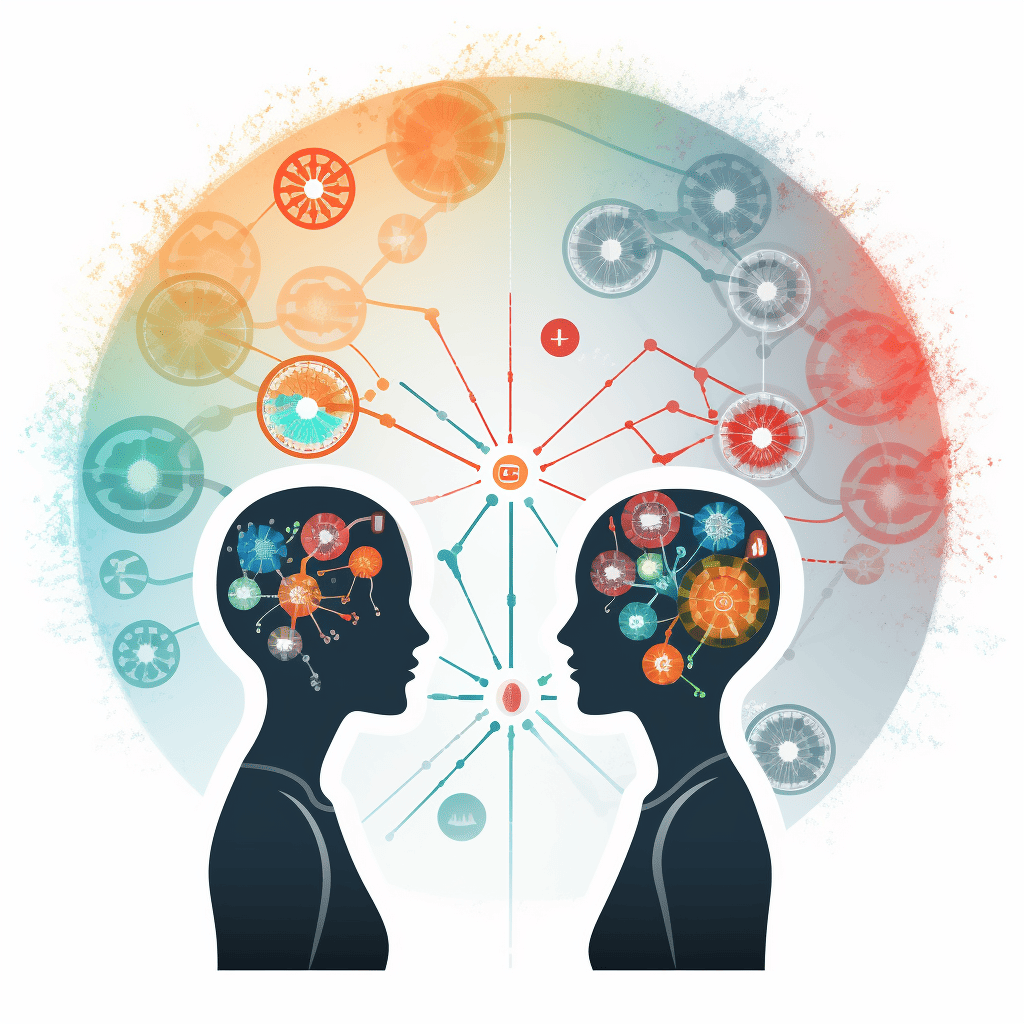There are lots of types of therapy for mental health. Two main ones that are popular are Cognitive Behavioral Therapy (CBT) and Dialectical Behavior Therapy (DBT).
CBT and DBT are types of psychotherapy that help people manage their emotions and change unhelpful thoughts and behaviors.
In this article, you'll learn about CBT and DBT, including their origins, applications, and how they benefit those in need. By the end, you'll have a clear understanding of each therapy and know how to differentiate them like an expert.
What is Psychotherapy?

Whether it's talk therapy or group therapy, psychotherapy offers many different treatment styles. Each style is designed to help individuals navigate the complexities of their minds, emotions, and behaviors.
Psychotherapy, often simply called "therapy," is a process where individuals work with trained professionals to explore and resolve personal challenges, be they emotional, mental, or behavioral.
There are numerous therapeutic approaches, each with its unique methods and principles. Some focus more on mental health disorders, while others focus on overall mental health.
Some therapies, like CBT, focus on identifying and altering negative thought patterns. It's great for treating depression and maladaptive behaviors. It's often taught in group sessions or in a skills training group. In other words, CBT focuses on critical thinking and behavioral skills.
In contrast, others, like DBT, blend cognitive techniques with emotional regulation and interpersonal skills. Talk therapy sessions focus on things like suicidal ideation and other harmful behaviors. In other words, DBT treats emotional response.
The choice of therapy often depends on an individual's specific needs, challenges, and desired outcomes.
As you prepare to learn more about CBT and DBT, remember they're just two types of psychotherapy.
Origins of Cognitive Behavioral Therapy (CBT)
When you first hear about Cognitive Behavioral Therapy (CBT) it might seem like another buzzword in psychotherapy. But when you explore its roots, you'll realize CBT isn't a modern-day fad.
Sometimes called "Cognitive Behavioral Treatment," CBT therapy is a structured, goal-oriented therapy that has evolved over decades. It's firmly anchored in a rich history of psychological research and breakthroughs.
The origins of CBT trace back to the 1960s. A talented psychiatrist named Dr. Aaron T. Beck began noticing a pattern among his depressed patients.
Traditional psychoanalytic theories focused on unconscious feelings and past traumas as the cause of depression. Dr. Beck identified something different.
He recognized that his patients often held un-true, negative thoughts about themselves, their world, and their future.
Think of these distorted thoughts like a pair of smudged glasses. Just as dirty lenses can skew your vision, these negative thought patterns can distort a person's perception of reality.
Dr. Beck's observations led him to develop a cognitive therapy program that targeted these negative thought and behavior patterns. CBT aims to help people learn how to clean their lenses, so to speak.
The goal was simple yet profound: change the thought, and you can change the behavior. Rather than delving deep into a patient's past, like traditional psychotherapy, CBT focused on the present. It offers practical tools to change those harmful thought patterns and influence behaviors.
Over time, CBT expanded its scope, integrating elements from other therapeutic approaches. It became a term for a collection of therapies grounded in the belief that our thoughts, feelings, and behaviors are connected.
So, when you encounter challenges or feel stuck in a cycle of negative thinking, remember that CBT offers a pathway to identify, challenge, and reshape those thoughts. It’s like cleaning those smudged glasses, offering a clearer and more positive view of the world.
Key Principles and Concepts of CBT
Stepping further into the world of Cognitive Behavioral Therapy, it's a bit like learning the rules of a new board game. At first, there might be many pieces and instructions, but once you grasp the main principles, everything becomes clearer.
So, let’s unravel the core concepts of CBT, making them as easy to understand as the rules of your favorite game.
Thoughts Influence Feelings and Behaviors
At the heart of CBT is a straightforward idea: how you think affects how you feel and act.
For instance, if you constantly think, "I'm not good enough," you'll likely feel down and might avoid trying new things.
Identify Negative Patterns
One primary goal of CBT is spotting repetitive negative thoughts. It’s like catching a repetitive song that keeps playing in your mind. Once you're aware of the tune, you can work on changing it.
Challenge and Replace
After spotting these thoughts, the next step is challenging them. Are they based on facts or just assumptions?
Then, replace them with more positive, realistic ones. Think of it as tuning a radio from a station playing sad songs to one with uplifting melodies.
Skills Training
CBT isn’t only about thoughts. It equips you with practical tools and strategies to cope with challenges. Imagine having a toolkit filled with everything from a hammer to a screwdriver. Each tool is designed to tackle specific life challenges.
Goal-Oriented and Structured
CBT sessions are much like school lessons. There's a clear plan, goals to achieve, and homework to ensure you practice what you've learned.
And just like mastering a subject in school, with time and effort, you can master the techniques of CBT.
Short-Term and Focused
Unlike some therapies that continue indefinitely, CBT is often short-term. Think of it as a brief, intensive training course. In just a few sessions with right therapist, many individuals find significant relief and learn techniques they can use for a lifetime.
CBT Treatment

Imagine walking into a large library, where each book represents a different challenge or issue people face in their lives. Some books are about stress, others about phobias, and some even on deeper issues like depression.
Now, think of Cognitive Behavioral Therapy (CBT) as a versatile tool, like a universal key, that can unlock solutions to many of these challenges. Let’s explore where and how this key is typically used in real-life clinical settings.
Anxiety Disorders
Ever felt your heart racing before a big event or presentation? That's anxiety, a normal emotion. But for some, this feeling becomes overwhelming and constant.
CBT is great at treating anxiety. It helps by teaching techniques to calm the mind and body, almost like learning breathing exercises before diving underwater.
Depression
We all have gloomy days, but depression is like an overcast sky that doesn’t seem to clear. CBT aids by changing those persistent negative thought clouds into clearer, more hopeful skies.
Phobias
Imagine being petrified of something specific, like spiders or heights. Through CBT, individuals confront these fears. Eventually, they get comfortable with these fears, turning mountains into manageable molehills.
Obsessive-Compulsive Disorder (OCD)
Ever double-checked if you locked the door? It’s normal. But for someone with OCD, these checks become repetitive and intrusive. CBT provides strategies to break this loop.
Post-Traumatic Stress Disorder (PTSD)
Some events leave deep emotional scars. CBT can be the gentle guide, leading individuals through healing paths, helping them process and move past traumatic memories.
Eating Disorders
For some, food-related thoughts can become all-consuming. CBT helps to reshape these thoughts, like adjusting a recipe to make it healthier and more balanced.
Insomnia
When sleep eludes night after night, CBT can step in as a gentle lullaby. It introduces habits and thoughts that promote restful sleep, ensuring dream-filled nights.
Chronic Pain
Physical pain is challenging, but the way we think about it can either amplify or ease it. CBT offers techniques to cope, like a musician adjusting the volume of a loud speaker.
Origins of Dialectical Behavior Therapy (DBT)
The mental health clinician Dr. Marsha M. Linehan designed Dialectical Behavior Therapy (DBT) in the 1980s. She created it to help individuals struggling with self-harming behaviors and suicidal thoughts.
Dr. Linehan noticed something essential: while CBT was an effective treatment for many, there were individuals who found its straightforward problem-solving approach a bit challenging.
These individuals often felt invalidated or misunderstood. It was like telling someone with a fear of water to just jump into the pool without recognizing their deep-seated fears.
To address this, DBT introduced the concept of dialectics. Now, that might sound like a hefty word, but it's quite simple. Dialectics is about balancing opposites. Basically, accepting oneself as they are while also acknowledging the need for change.
In essence, DBT combines the practical problem-solving techniques of CBT with a strong emphasis on acceptance and validation.
Sometimes DBT is called "dialectical behavioral therapy."
Key Principles and Concepts of DBT

To understand the depth of DBT, we must first become familiar with its core principles and concepts.
Mindfulness
Picture yourself sitting calmly by a serene lake, observing everything around you without judgment. That’s the essence of mindfulness.
DBT emphasizes being fully present in the moment, noticing thoughts and feelings without getting caught up in them. It’s about observing life as it unfolds, like watching birds fly by without trying to change their path.
Distress Tolerance
Life isn’t always smooth sailing. There are storms and choppy waters. Distress tolerance is like having a sturdy life jacket during those turbulent times.
It teaches individuals to bear pain and distress without making things worse. Instead of panicking in the storm, it's about floating patiently, waiting for clearer skies.
Emotion Regulation
We all experience a lot of different emotions. Some days are sad, others are happy or excited. Emotion regulation is about understanding and managing the variety of emotions. It provides techniques to change unwanted emotions, ensuring that our life’s canvas is balanced and harmonious.
Interpersonal Effectiveness
Relationships can be tricky. Imagine playing a duet with someone. If both musicians aren’t in harmony, the music sounds off.
Interpersonal effectiveness gives people the skills to communicate and interact better.
Walking the Middle Path
Remember the concept of dialectics? This principle is its practical application. It's about finding balance, like a tightrope walker carefully treading the line.
DBT teaches acceptance of many truths, understanding that two seemingly opposite things can coexist. It's recognizing that you can be doing your best and still have room for growth.
With these principles, the world of DBT is a therapy that’s both compassionate and structured. It offers not just tools but a whole new perspective, helping individuals balance the dance of acceptance and change in their lives.
DBT Treatment
Let’s look at some areas that DBT is used to help people. Remember, DBT focuses on individual time with a mental health professional.
When you think of DBT vs CBT, DBT is not as focused on mental health conditions.
Borderline Personality Disorder (BPD)
This was the initial and primary reason DBT was developed. Individuals with BPD often experience intense emotional swings and struggle with relationships.
DBT offers strategies to manage these intense feelings and improve interpersonal interactions, helping create a sense of stability. It's also great at treating other personality disorders.
Self-Harming Behaviors
Some individuals use self-harm as a way to cope with emotional pain. DBT equips them with safer alternatives and coping mechanisms.
Suicidal Thoughts
DBT offers a structured approach to individuals with suicidal thoughts, teaching them skills to manage these intense feelings and build a life they feel is worth living.
Eating Disorders
Like CBT, DBT can help those whose relationship with food is challenged, offering ways to accept oneself while also making healthier choices.
Substance Use Disorders
For those trapped in the cycle of substance abuse, DBT offers techniques to tolerate distress without turning to drugs or alcohol. It also teaches skills to build a more fulfilling life without substances.
PTSD (Post-Traumatic Stress Disorder)
DBT can complement other treatments for PTSD. It's especially good for people who find it challenging to regulate their emotions. It's also good individual therapy and for teaching how to maintain stable relationships after traumatic events.
Chronic Depression
For some, depression lingers like a shadow, even after trying various treatments. DBT offers an alternative approach, helping individuals accept their feelings while also finding ways to lift the gloom.
Comparison: CBT vs DBT
These two therapies, though distinct, share some common ground.
| Feature/Aspect | Cognitive Behavioral Therapy (CBT) | Dialectical Behavior Therapy (DBT) |
|---|---|---|
| Core Focus | Concentrates on identifying and altering negative thought patterns. | Blends changing thought patterns with a focus on acceptance, emotional regulation, and interpersonal effectiveness. |
| Session Structure | Goal-oriented with a clear structure focusing on current problems. | Structured, goal-oriented, but places significant emphasis on validation and acceptance along with change. |
| Thoughts & Behaviors | Acknowledges the strong link between thoughts, emotions, and behaviors. Aims to modify negative thought patterns to influence positive behavioral changes. | Recognizes the interconnectedness of thoughts, emotions, and behaviors. Combines this with strategies for acceptance and emotional regulation. |
| Emotional Regulation | Addresses emotional concerns within the framework of changing thought patterns. | Offers deeper techniques specifically for managing and understanding intense emotions. |
| Dialectics | Not a primary feature of CBT. | Central to DBT. Teaches balancing opposites and finding a middle ground, promoting a nuanced view of life. |
| Validation | While understanding is important, there isn't a pronounced focus on validation. | Strong emphasis on ensuring individuals feel validated and understood, even as they work towards change. |
To sum it up, while CBT and DBT both provide tools for addressing thought patterns and behaviors, DBT therapy goes a step further by adding acceptance strategies and a deeper focus on emotional experiences.
Practical Examples: CBT vs. DBT in Action
Sometimes, to truly grasp a concept, we need to see it in action. Let's look at a few examples of Cognitive Behavioral Therapy (CBT) and Dialectical Behavior Therapy (DBT) in real-life scenarios.
Alex's Journey with CBT
Alex has been struggling with anxiety about public speaking. Every time he thinks about presenting in front of his class, he's consumed by thoughts like "I'll mess up" or "Everyone will laugh at me."
In CBT sessions:
- Alex learns to identify these negative thoughts.
- Together with his therapist, they challenge the accuracy of these beliefs. Is it true everyone will laugh, or is it just a fear?
- Alex practices replacing these thoughts with more realistic ones, such as "I'm prepared, and even if I make a mistake, it's okay."
Over time, Alex feels more confident. He learns to shift his mindset, focusing on preparation and acceptance rather than fear.
Jordan's Experience with DBT
Jordan feels emotions intensely. A small disagreement with a friend can spiral her into feelings of abandonment and sadness. Sometimes, these emotions become too much, leading her to impulsive actions she later regrets.
In DBT sessions:
- Jordan learns mindfulness techniques, practicing being present in the moment without judgment.
- When overwhelmed, she's taught distress tolerance skills. Instead of acting impulsively, she learns to pause and use coping strategies.
- Emotion regulation tools help Jordan understand her feelings better, allowing her to respond rather than react.
- Through interpersonal effectiveness, she practices assertive communication, ensuring her relationships are more balanced and less conflict-prone.
With her DBT skills, Jordan learns to navigate her emotions with more grace and understanding. She feels less controlled by her intense emotions.
Sam's Path with CBT
Sam frequently doubts his accomplishments, often attributing his success to pure luck. This "imposter syndrome" makes him fear that one day, everyone will discover he's a fraud.
In CBT sessions:
- Sam learns to recognize these self-deprecating thoughts.
- He and his therapist test the evidence supporting these beliefs. Have there been real instances that justify these feelings, or are they unwarranted fears?
- Sam practices reframing these thoughts, reminding himself of his hard work and achievements.
Over time, Sam's confidence grows. He begins to internalize his accomplishments, understanding that they're a result of his efforts, not just luck.
Lila's Journey with DBT
Lila struggles with mood swings. Minor setbacks can send her into a spiral of despair, while small achievements can lead to extreme euphoria.
In DBT sessions:
- Lila is introduced to mindfulness exercises, helping her remain grounded during emotional highs and lows.
- When feeling overwhelmed, Lila uses distress tolerance tools, like deep breathing or distraction techniques.
- Emotion regulation strategies help Lila identify triggers and responses.
- She learns interpersonal effectiveness skills to communicate her needs and set boundaries, ensuring healthier relationships.
Through DBT, Lila develops resilience and emotional consistency, improving her well-being and interpersonal relationships.
Noah's Experience with CBT
Noah is terrified of social situations, always assuming others are judging or mocking him. This social anxiety prevents him from attending gatherings or making new friends.
In CBT sessions:
- Noah starts by identifying specific fearful thoughts linked to social situations.
- He and his therapist challenge these beliefs, assessing their reality basis. How often do people genuinely judge or mock?
- They use gradual exposure exercises where Noah attends small gatherings to slowly build his confidence.
With time and CBT, Noah starts enjoying social interactions, realizing that most of his fears were unfounded.
Mia's Path with DBT
Mia has a history of unstable relationships, often feeling that people will abandon her. These feelings sometimes lead to outbursts or desperate attempts to avoid perceived abandonment.
In DBT sessions:
- Mia is taught mindfulness techniques to stay present during emotional upheavals.
- Distress tolerance skills help Mia cope during intense moments without resorting to extreme actions.
- Emotion regulation tools assist Mia in understanding her fears and reactions.
- Interpersonal effectiveness skills help her build more stable and fulfilling relationships.
Through her DBT journey, Mia learns to foster healthier relationships, understanding her fears, and finding ways to communicate more effectively.
Memory Tricks for Distinguishing Between CBT and DBT

Understanding the nuances of CBT and DBT can feel a bit like trying to remember the ingredients of two similar yet distinct recipes.
While they might share some key concepts, each therapy has its unique techniques. Here are some easy-to-remember tips and tricks to help you distinguish key differences between the two:
1. Recipe Basics vs. Advanced Cooking: Think of CBT as the basic recipe everyone should know. It focuses on the link between thoughts, feelings, and behaviors. But DBT is like an advanced cooking course. It incorporates the basics of CBT but adds more layers, like emotion regulation and dialectics.
2. Problem-Solving vs. Acceptance: CBT is about identifying and solving problems in thinking patterns. DBT, while also addressing problems, places a strong emphasis on accepting oneself and the current situation.
3. The Here and Now vs. The Balance: CBT often focuses on present thoughts and behaviors. DBT, while also concerned with the present, emphasizes finding a balance between acceptance and change.
4. Thoughts Central vs. Emotions Central: DBT has a strong focus on managing and understanding intense emotions. CBT does not.
5. Universal vs. Specialized: While both therapies can cater to a range of mental health issues, CBT has a more universal approach. DBT was designed for specific challenges, like borderline personality disorder, though its applications have expanded over time.
Which Therapy is Right for You?
Do you think it might be time to seek therapy?
Navigating the world of talk therapy can feel like standing at a crossroad, trying to decide which path will lead to the desired destination.
Cognitive Behavioral Therapy (CBT) and Dialectical Behavior Therapy (DBT) are two prominent paths in this therapeutic journey.
Yet, choosing between them is not about finding the 'better' option but rather identifying which one aligns best with your unique needs and circumstances. And if you already have a treatment history, it might be worth trying a different type.
Understanding Your Challenges
If your primary struggles revolve around specific negative thought patterns or behaviors, CBT might be your go-to. Think of CBT to help with problematic behaviors and a mental health condition.
But, if your challenges are more centered around intense emotions, unstable relationships, or if you're seeking a balance between accepting difficulties and making changes, DBT could be the better option. Think of DBT to help you manage emotions, improve interpersonal relationships, and gain coping skills.
Duration and Depth
CBT is often a shorter-term therapy, designed to address specific issues in a structured manner. Think of it as a crash course, equipping you with essential skills in a concise timeframe.
DBT can be more intensive, especially when addressing complex emotional challenges. It's like attending a comprehensive workshop that delves deep into various modules of emotion, acceptance, and change.
Flexibility and Specificity
Remember, therapy isn't a one-size-fits-all. While CBT offers broad tools applicable to various challenges, DBT provides specialized techniques, initially tailored for specific conditions like borderline personality disorder.
Seeking Professional Guidance
Remember, if you try one and don't like it, you can always try the other one! Or maybe your therapist will suggest a different type of therapy altogether. There's no shame in one not working.
In the end, whether you choose CBT, DBT, or even another therapeutic approach, the goal is to find a path that helps you grow, heal, and thrive. It's not about the label of the therapy, but the positive change it brings into your life.
